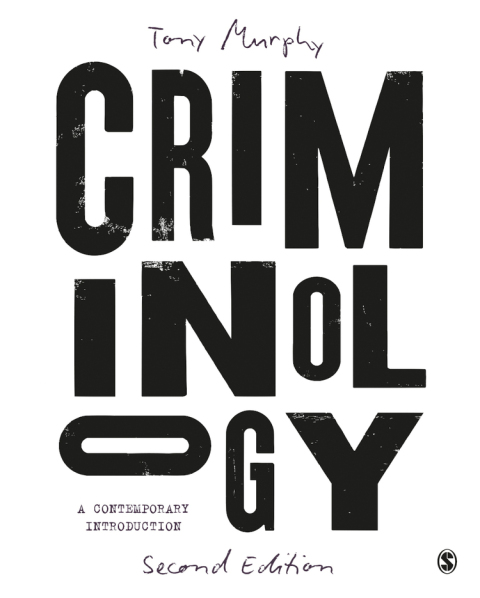Description
Efnisyfirlit
- About the Author
- Online Resources
- Acknowledgements
- 1 Introducing the landscapes of criminology
- 1.1 Introducing the text
- 1.2 Structure of the text
- 1.3 What is ‘criminology’?
- 1.4 Skills and competencies of a criminologist
- 1.5 Key topics in criminology
- 1.6 What is ‘crime’?
- 1.7 Types of crime
- 1.8 Summary and implications
- Recommended reading and follow-up material
- Part 1 Understanding the causes and prevalence of crime
- 2 ‘Theory’ and its uses
- 2.1 What is theory?
- 2.2 The ‘problems’ with theory
- 2.3 Key examples of theories in criminology
- 2.4 How is theory created and how does it work?
- 2.5 Summary and implications
- Recommended reading and follow-up material
- 3 Criminological theory: the causes of crime
- 3.1 Approaching theories of crime
- 3.2 Accounting for crime
- 3.3 Different crimes, different explanations?
- 3.4 The different explanations: introducing the five blocks
- 3.5 Mapping out the blocks
- 3.6 Block one: choice and decision-making
- 3.7 Block two: individual pathologies
- 3.8 Block three: social pathologies
- 3.9 Block four: critical approaches
- 3.10 Block five: integrated approaches
- 3.11 Summary and implications
- Recommended reading and follow-up material
- 4 Doing criminological research
- 4.1 Introducing research in criminology
- 4.2 Doing research: the research process
- 4.3 Ethics and research
- 4.4 Epistemology and ontology
- 4.5 Choosing a research approach/method
- 4.6 Sampling
- 4.7 Research validity
- 4.8 Summary and implications
- Recommended reading and follow-up material
- 5 Counting crime
- 5.1 Counting crime: what to count?
- 5.2 How do we count crime?
- 5.3 Official recorded data on crime
- 5.4 Victimisation surveys
- 5.5 Other data sources on crime
- 5.6 Revisiting the iceberg analogy
- 5.7 Summary and implications
- Recommended reading and follow-up material
- Part 2 Social divisions and crime
- 6 The politics of law and order
- 6.1 Politics and law and order: crime policy as currency and baggage
- 6.2 The role of the media
- 6.3 The impacts of political influence on law and order processes
- 6.4 The focus on drugs
- 6.5 President Donald Trump: penal populist par excellence?
- 6.6 Politics of law and order in a wider context
- 6.7 Summary and implications
- Recommended reading and follow-up material
- 7 Offenders and victims
- 7.1 Defining ‘victim’ and ‘offender’
- 7.2 The data on victims and offenders
- 7.3 Conceptualisations of offender and victim
- 7.4 Unconventional offenders and victims
- 7.5 Conceptualising the vulnerability to victimisation and offending
- 7.6 Summary and implications
- Recommended reading and follow-up material
- 8 Media and Crime
- 8.1 Introducing the link between the media and crime
- 8.2 Crime in different media forms
- 8.3 Crime content in the media
- 8.4 Moral panics and deviancy amplification
- 8.5 Social media and crime
- 8.6 Policing and the media
- 8.7 Summary and implications
- Recommended reading and follow-up material
- Part 3 Dealing with crime and justice
- 9 Punishment
- 9.1 Power, authority and legitimacy to punish
- 9.2 Punishment at an international level
- 9.3 Why punish?
- 9.4 Types of punishment
- 9.5 Outcomes and consequences of how we respond to crime
- 9.6 The death penalty
- 9.7 Critical issues of punishment
- 9.8 Summary and implications
- Recommended reading and follow-up material
- 10 Social policy and crime
- 10.1 Understanding the connection between social policy and criminology
- 10.2 Policy overlaps
- 10.3 Inequality matters
- 10.4 Case study: homelessness
- 10.5 Summary and implications
- Recommended reading and follow-up material
- 11 Global justice
- 11.1 The need to think ‘global’
- 11.2 International standards: social justice
- 11.3 International standards: human rights
- 11.4 People trafficking
- 11.5 Application of criminological theories
- 11.6 Summary and implications
- Recommended reading and follow-up material
- 12 Moving towards a harms-based approach
- 12.1 The problem with ‘crime’: a harms-based alternative
- 12.2 Social murder
- 12.3 Structural violence
- 12.4 Assessing a social harms approach
- 12.5 Summary and implications
- Recommended reading and follow-up material
- 13 Conclusion
- 13.1 Summary of the text
- 13.2 Putting it all together
- 13.3 Criminological futures
- 13.4 Final activity
- References
- Index







Reviews
There are no reviews yet.